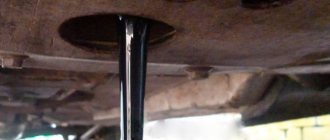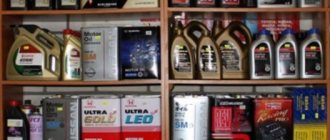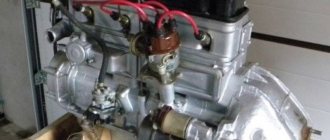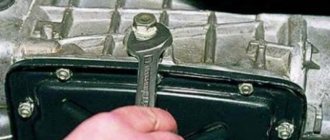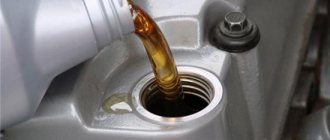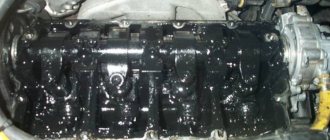To select a car oil, no professional experience is required - minimal theoretical knowledge, which is in the operating instructions, is sufficient. In order not to make a mistake in your choice, it is enough to know the parameters of viscosity, tolerance, degree of quality, types of motor oils, as well as their best manufacturers. You also need to be aware of the volume of oil being poured, otherwise underfilling or overfilling can lead to problems with engine operation. In this article, using the example of the popular Lada Vesta car, we will consider in detail how to choose the right engine oil.
Replacement frequency
The AvtoVAZ company recommends pouring oil into the Vesta engine every 10 thousand kilometers. According to auto experts, this is quite an optimal indicator, taking into account the harsh climatic conditions in Russia. In the European region, the requirements are completely different, and may differ for the better. Under the influence of negative climatic factors, the liquid quickly becomes unusable, as a result of which the oil loses its beneficial properties and is no longer able to cool engine components, and thereby prevent them from overheating. If the car is subjected to extreme loads - for example, driving on light off-road conditions, including dusty roads, or carrying a heavy load and moving at high speed, this also negatively affects the life of the oil, and at the same time affects the reliability of the power plant. In such cases, it would be advisable to reduce the oil change schedule even further - up to 7-5 thousand kilometers. At the very least, this will protect the engine from premature wear of components, due to the rapid loss of the oil’s beneficial properties.
The most popular articles on the site:
- How often should you change engine oil?
- Oil 5w30 and 5w40 what is the difference
- What oil to pour into the engine in winter and summer
- How long does it take to change the automatic transmission oil?
Preparatory work before changing the oil
A car from the Russian Federation Lada Vesta, as expected, should undergo specialized technical maintenance every 15 thousand kilometers. At the same time, experts recommend, if possible, reducing this time interval to 10-12 thousand kilometers. The car needs to be prepared for the subsequent replacement of engine fluid, the necessary common tools and new consumables must be purchased. The oil change itself is performed after your car has been driven, that is, when the oil has still had time to cool. If the car was parked, then before replacing it you need to start it and let the engine run a little, about 15-20 minutes. Then we drive the car into a pit or, if convenient, an overpass.
What is needed to change the fluid in a Vesta model engine:
- Suitable fresh new oil;
- New suitable oil filter;
- A specialized puller of the so-called chain type;
- A socket wrench with attachments and always with hexagons;
- An ordinary screwdriver.
Once you have prepared everything, you can move on to the most important part - changing the oil.
How to understand that the oil has become unusable
There are several reasons why your oil may be in poor condition. So, first you should check the amount of oil. This can be done using the dipstick, which is located in the oil filler hole. The dipstick must be pulled out of the hole and look at the oil imprint. If its color is dark brown (initially it was transparent), then this clearly indicates traces of mechanical wear. In addition, there are other factors - for example, smell - if the liquid smells burnt, this also indicates problems caused by pouring low-quality oil and the consequences of unfavorable weather and road conditions. The situation is further aggravated by the fact that the oil may contain sediment in the form of metal particles. In this case, the oil will have to be replaced urgently, otherwise you may face irreversible consequences fraught with major engine overhauls.
How much oil to pour into the Lada Vesta engine
Information on the oil volume for the Lada Vesta is located on the last pages of the operating instructions. For this machine, the volume of oil to be filled depends on the engine lubrication system:
– 21129 (cast oil sump) – 4.4 l;
– 21129 (stamped oil sump) – 3.2 l;
– 21179 (cast oil sump) – 4.4 l.
The figures specified by the manufacturer should be strictly adhered to: a volume less than recommended can lead to oil starvation under certain operating conditions of the engine and, consequently, to increased wear. And if the oil level is much higher, it will begin to be squeezed out through the crankcase ventilation or breather, and can also damage the catalyst
Remember to check the oil level regularly. And if a new car under mild operating conditions can be checked at regular maintenance, then for used cars with high mileage and severe operating conditions, regular checks cannot be avoided. The oil level in the Lada Vesta engine is checked on a cold engine:
- Place the machine on a level surface;
- Remove the oil dipstick and wipe it with a cloth;
- Push the dipstick back in and then pull it out again;
- The optimal oil level on a cold engine is between the Min and Max marks.
| Lubrication system | Oil volume, l |
| 21129, cast oil sump | 4,4 |
| 21129, stamped oil sump | 3,2 |
| 21179, cast oil sump | 4,4 |
When is an oil check needed?
Typically, car enthusiasts prefer to wait for the replacement schedule, and only then check the oil - when it’s too late. It is advisable to check the condition of consumables in advance, because this will avoid problems with the motor. So, you need to check the oil if you notice the following signs:
- Insufficient engine power
- The motor is not able to develop high speeds
- High fuel consumption
- Excessive oil consumption
- Gearbox shifts with delay
- Noises and vibrations
Features of changing the oil in Lada Vesta and related work
In modern cars, the oil is changed together with the oil and cabin filters. The oil filter retains waste products when the engine is running and extends the life of the oil. If you refuse to replace it, it is possible to provoke extreme contamination of the filter, which will lead to an increase in pressure in front of the filter, and subsequently to the operation of the bypass valve. Then the oil will bypass the filter and will not be cleaned; the car cannot be operated in this case.
And replacing the cabin filter is especially important for residents of large cities with questionable ecology: a fresh filter will allow you to breathe clean air even on the busiest streets and in traffic jams.
What else needs to be checked along with an oil change? First of all, these are: drive belt, suspension, wheel alignment, condition of brakes and cooling system, tire pressure (it is good to carry out this procedure regularly between maintenance services), and oil level in the gearbox.
Types of motor oils
Today there are three types of oils on the market, let’s look at them in more detail.
- Synthetic is the best motor oil today. It has high fluidity and resistance to low temperatures. It can be safely recommended for Lada Vesta, as well as for other modern cars, including premium ones. Lada Vesta is the most modern AvtoVAZ car, consuming only high-quality consumables.
- Mineral is the most affordable motor oil. It has an excessively thick consistency, which makes it impossible to use in frosty conditions. It is only suitable for warm climates. In addition, it will have to be changed much more often than synthetic oil.
- Semi-synthetic – a mixture of synthetic and mineral oils. The best option for Lada Vesta in terms of cost and combination of useful properties. Definitely better and more modern than mineral oil.
Manufacturer's recommendations
Some recommendations on the type of lubricant used and its replacement can be found in the Lada Vesta operating manual, according to the instructions:
Edge 5W30 oil from the Castrol brand is an all-season synthetic that provides the internal combustion engine with reliable protection even at extreme loads, stable starting at low temperatures (down to -30 C). With this MM, the engine runs smoothly, and some fuel savings are even noted.
Helix HX8 5W40 from the manufacturer Shell is a high-quality synthetic oil at an affordable price, retains its original properties for a long time, and does not thicken in the cold.
Car owners also note its low consumption, and among the shortcomings it is worth highlighting only the fairly common counterfeit, since this brand is widely popular.
The best semi-synthetic oils for Lada Vesta
After the warranty period expires, you can switch to semi-synthetic oil. It has proven itself well in European winter conditions, when the air temperature in winter rarely drops below -20°C. Experts have selected several suitable motor oils.
SHELL Helix HX7 10W-40
SHELL Helix HX7 10W-40 semi-synthetic product deserved the most flattering words from experts. It combines affordability with a long service life. If most competitors manage to make semi-synthetic oil with a service life of 5 thousand km, then SHELL Helix HX7 can be changed after 7 thousand km. The advantages of the lubricant include maintaining fluidity at low temperatures. The product received all these properties thanks to the combination of a synthetic and mineral base. It should also be noted that there are unique detergent additives that keep the Lada Vesta engine perfectly clean.
Semi-synthetics win our rating for durability, versatility of use and reasonable price. You should only buy it from trusted suppliers due to the presence of counterfeit products on the market.
Advantages
- acceptable price;
- unique recipe;
- wear resistance;
- excellent cleaning ability.
Flaws
- there are fakes.
Castrol Magnatec 10W-40 R
When developing semi-synthetic oil Castrol Magnatec 10W-40 R, the British manufacturer was guided by Russian climatic conditions. This approach did not go unnoticed by our experts, who recommend using the product in Lada Vesta. The low thickening temperature deserves special praise; even at -35°C the lubricating fluid retains its fluidity. Numerous tests have confirmed the frost resistance of the material, for which it occupies the second line of our rating.
Motorists from Russia appreciated the affordable price, resistance to low temperatures, and high-quality manufacturing. But this petroleum product is also actively counterfeited, so it is best to buy oil from trusted sellers.
Advantages
- reasonable price;
- adaptation to the Russian climate;
- frost resistance;
- quality production.
Flaws
- a lot of counterfeit products.
TOTAL Quartz 7000 10W40
Semi-synthetic oil TOTAL Quartz 7000 10W40 is popular among domestic motorists. This lubricant is poured into engines of gasoline and diesel cars. The product was developed taking into account modern requirements; it is suitable when using unleaded gasoline and liquefied gas. Experts highly appreciated the stability of viscosity in heat and cold, the preservation of technical parameters under different riding styles. Excellent dispersing properties keep the heart of the machine clean. TOTAL Quartz 7000 takes an honorable third place in our ranking.
Russian car owners praise French oil for its affordable price, endurance and durability. It is not recommended to pour it into old engines, as there is significant waste.
Advantages
- affordable price;
- endurance;
- durability;
- versatility.
Flaws
- waste on old engines.
LUKOIL Genesis Advanced 10W-40
Russian oil LUKOIL Genesis Advanced 10W-40 is intended for all-season vehicle operation. It is developed based on synthetic technologies and is suitable for gasoline and diesel engines. The product is suitable for both the domestic Lada Vesta and a wide range of foreign cars. Experts note reliable wear protection, increased additive content, and excellent cleaning properties. Of particular interest to Russian motorists is its excellent pumpability at low temperatures. In this indicator, the lubricating fluid is many times superior to its famous competitors.
Semi-synthetics stopped one step away from the top three. Motorists have discovered such a drawback as the appearance of a knocking sound in hydraulic compensators when the engine is warm.
Advantages
- high technical parameters;
- easy scrolling in moderate frosts;
- good cleaning properties;
- protection against counterfeiting.
Flaws
- hydraulic compensators are knocking.
Step-by-step process for replacing Vesta engine fluid
We mean that changing the oil in the engine of a modern domestic Lada Vesta car begins with dismantling the plastic that covers the engine.
Next, remove the cover of the so-called neck where the oil is poured, and dismantle the plastic shield located at the bottom of the motor, thus protecting it from dust and dirt. This shield is fastened with 13 ordinary bolts, which have 10 heads.
The next step is to clean the oil pan, exactly where the plug from the drain neck is located; also, using a regular hexagon 8, we unscrew the plug itself.
We remind you that before these manipulations you should place some convenient unnecessary container, for example a basin, under the special drain neck, because it is from there that the used oil will be drained. Let us add that you also need to be careful in this matter, because the oil is quite hot and if it gets on your skin, it can cause burns.
It is necessary to drain the engine fluid until it stops dripping from the specialized drain hole. After that, use a piece of clean cloth to wipe off the dirt that has accumulated on the plug and screw it into its rightful place. Plus, do not forget to remove any oil stains that have formed from the surface of the crankcase.
Already at the next stage of replacement, it is necessary to install an unnecessary container for used motor fluid where the oil filter is located, because when the oil is changed in the car, it is obvious that replacing the filter is mandatory. To replace the filter we have designated, you need to disconnect the wiring harness coming from it from the crankshaft sensor, and carefully move it aside so as not to damage it in any way.
It is not necessary to remove the sensor itself at all, but in this case you will have limited space to work, therefore, if you are uncomfortable, then you will have to remove the above mentioned sensor.
On-board computer for Kalina State
Wiring diagram Kalina
Replacing front pads Kalina
To remove the sensor, use a 10mm wrench. Take a pre-prepared chain puller and use it to loosen the filter. After which it can be easily unscrewed and thus removed.
Then we take a new oil filter and carefully pour fresh oil into it, approximately 50 percent of its capacity. You should also carefully lubricate the o-ring of the filter itself with fresh oil and screw it into place, but remember that before installing the new oil filter, its seat must be cleaned of dust and dirt.
Then, when the new oil filter is correctly installed, it must be tightened until the cylinder block directly contacts the so-called sealing ring located on the filter, and then turn another 75 percent of a turn. And after this the oil is filled. And here a logical question arises: how much oil to pour into the car engine? We answer, for the domestic car LADA Vesta, the optimal oil level directly for filling is 4.4 liters.
We also add that not all car owners have a chain puller, and therefore, if you don’t have one, you can use the following method: drive a screwdriver into the old used filter and directly use it as a kind of lever for unscrewing the filter. The most important thing here is not to damage the engine fitting in any way. In addition, remember that the engine in this car with AMT has a slightly smaller volume of motor fluid. How much oil should I pour into the engine in this case? 3.2 liters.
Beware of fakes!
The automotive chemicals market offers a lot of high-quality products, but, unfortunately, counterfeit products are often found.
Although you can find various tips on the Internet on how to recognize a fake, sometimes it can only be determined in the laboratory.
It is impossible to guarantee complete protection against counterfeit oils, but the risk will be significantly reduced if you adhere to the following rules:
- always purchase auto chemicals from specialized retail outlets;
- do not buy goods at a suspiciously low price;
- check the packaging for holograms,
- pay attention to the quality of the label;
- ask the seller for a certificate.
Fake motor oil is often impossible to identify by appearance, but it can increase oil consumption, make it more difficult to start an internal combustion engine, especially in cold weather, and the lubricant itself will quickly lose transparency.
If there is any suspicion of counterfeit oil, you should immediately drain the oil and replace it immediately, since it is much more important to maintain engine performance than to save on engine oil.
Model: Lada Vesta
Engine oil
There are no “preferred” oils here anymore! All Vesta engines can be filled with any oil with API quality level SL or SM, as well as SN. The factory sets the viscosity parameters of the oil too wide. It is better to limit yourself to the following viscosity ranges depending on temperature:
| Minimum air temperature, °C | SAE viscosity grade | Maximum air temperature, °C |
| —40* | 0W-40 | 30 |
| —30 | 5W-30 | 25 |
| —30 | 5W-40 | 35 |
| —25 | 10W-30 | 25 |
| —25 | 10W-40 | 35 |
* Optimal oils for use in Russia are highlighted in bold.
If the temperature in your region is 40°C, then it makes sense to fill in 5W-50 type oils.
Specifications
power 21129 (127) – 106 hp. (21126 – 98hp)
Torque 21129 (127) – 150 N.m (21126 – 145 N.m.) at 4000 rpm.
Mixed fuel consumption is 7-10 liters per 100 km. More details about fuel consumption
Recommended fuel – AI 95
Motor weight – 115 kg.
The table above shows the torque and power graph of the 1.6L 21129 engine and its comparison with the 21179 1.8L engine.
Refueling containers, oil markings, prices
| Oil filter | ||
| Transmission oil | ||
| Coolant** | Eat | |
| Hydraulic clutch and brake system | Hydraulic brake system (for versions with AMT) | |
| Ozone-safe freon in the air conditioning system | ||
| Cabin filter | 1 | Eat |
| Engine air filter | 1 | Eat |
| Spark plug | 4 | |
| Accessory Drive Belt and Tensioner Pulley | 1 | Eat |
| Timing belt, tension and guide rollers | 1 kit | Eat |
| Front brake pads | 1 kit | Eat |
| Front brake discs | 1 kit | Eat |
| Rear brake pads | 1 kit | Eat |
| Rear brake discs | 1 kit |
| Name | Price, rub.) |
| Synthetic Rosneft 5W-30 (4 l) | From 900 |
| Maximum 5W-40 (4 l) | —/— |
| SM/CF (4 l.) | —/— |
| MOBIL 3000 5W40 (4 l) | From 1600 |
| Oil filter MAHLE OC384 | From 250 |
| Original m.f. 21050101200500 | From 300 |
*prices are as of January 31, 2019.
| Engine markings | Volume(l.cub.) |
| VAZ-11189 – 1.6 l | 3,6 |
| VAZ 21129 106 hp | 3.2 AMT |
| —/— | 4.4 manual transmission |
| VAZ 21179 – 1.8 l | 4,4 |
| HR16DE-H4M – 1.6 l | 4,3 |
Sequence of actions when changing the oil yourself
- We place the car on the inspection hole (hydraulic lift), open the hood, and warm up the engine to operating temperature.
- We provide priority safety measures by securing the rear row of wheels with wheel chocks.
- Open the filler neck and locate the vacuum.
- We find a mud shield under the bottom of the car and unscrew 13 bolts to “10” around the perimeter.
- We clean and rinse the protection from dirt and oily accumulations.
- We unscrew the plug.
- We wait for the liquid to drain completely, wipe the perimeter with a rag, remove any residue or oil leaks.
- We tighten the drain plug.
- We remove the filter, first disconnect the block with the crankshaft sensor wires.
- Install a new filter. Experienced professionals recommend and practice pouring 150 - 200 ml of oil into the cavity of the purifier.
- We assemble the parts in reverse order.
- We fill in new engine fluid, check the level, and replenish the missing amount.
- We start the engine, look at the dashboard, gauge display.
Oil Change Guide
Regardless of what oil you choose, what engine size you have and how much it contains, the following steps are performed:
- Remove the engine crankcase protection; to do this, unscrew the lower mounting bolts of the shield. The protection of the Lada Vesta has a special hole, so you do not always have to unscrew the shield bolts. However, during operation the cover becomes stuck or becomes covered with a layer of corrosion. In such cases, you may need some additional equipment, including pliers and a hammer.

